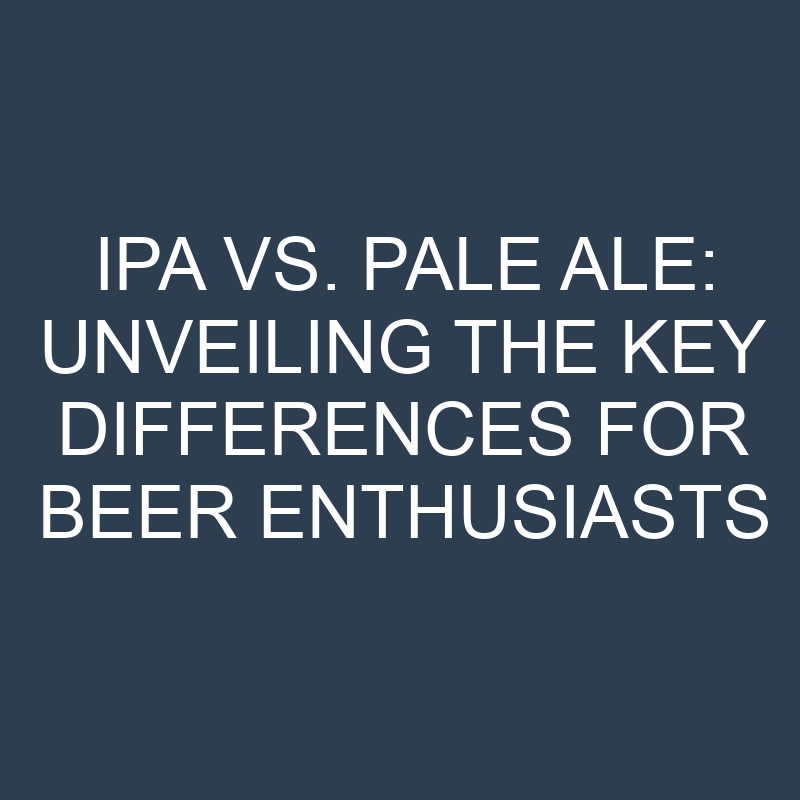
As a beer enthusiast, I’ve often found myself pondering the distinction between IPA and Pale Ale. These two popular beer styles share similarities but also have key differences that set them apart. Understanding these differences can enhance your appreciation for the diverse world of craft beer.
IPAs, or India Pale Ales, are known for their bold hoppy flavors and higher alcohol content. On the other hand, Pale Ales offer a more balanced taste with a focus on malt sweetness and subtle hop bitterness. Exploring the unique characteristics of each style can help you navigate the vast array of options available in the craft beer market.
Whether you’re a seasoned beer connoisseur or just beginning to explore the world of craft brews, delving into the nuances of IPA and Pale Ale can deepen your enjoyment and knowledge of these beloved beer styles.
Post Contents
Key Takeaways
- IPAs are distinguished by bold hoppy flavors and higher alcohol content, while Pale Ales offer a balanced taste with a focus on malt sweetness and subtle hop bitterness.
- IPAs showcase intense bitterness, floral/citrusy/piney aromas, and a dry finish due to higher hop usage, whereas Pale Ales exhibit more moderate hop bitterness allowing malt sweetness to shine.
- Characteristic differences in flavor profiles and brewing techniques between IPA and Pale Ale make them unique beer styles catering to different preferences.
- Exploring the variety within IPA styles such as West Coast, New England, and Double/IPA, along with the balanced profile of Pale Ales, opens up a world of flavors in craft brewing.
Understanding IPA and Pale Ale
When it comes to India Pale Ales (IPAs) and Pale Ales, the key differences lie in their flavor profiles and brewing techniques. IPAs are renowned for their bold hoppy flavors and typically have a higher alcohol content compared to Pale Ales. On the other hand, Pale Ales offer a more balanced taste with an emphasis on malt sweetness and subtle hop bitterness.
As an avid beer enthusiast, I always appreciate the distinctive characteristics that set these two styles apart. IPAs are known for their intense bitterness, floral, citrusy, or piney aromas, and a dry finish. They often use a higher amount of hops during brewing, which contributes to their signature sharp and sometimes resinous taste.
In contrast, Pale Ales exhibit a more moderate hop bitterness, allowing the malt sweetness to shine through. This results in a beer that is refreshing, slightly fruity, and with a more pronounced malt presence. Pale Ales are a great entry point for those new to craft beer, offering a balanced taste that is not overpowering but still flavorful.
Whether you prefer the boldness of an IPA or the subtle complexity of a Pale Ale, exploring these two beer styles can open up a world of flavors and aromas that showcase the artistry and creativity of craft brewing. So, next time you are at your local brewery or bottle shop, don’t hesitate to sample an IPA or Pale Ale and savor the unique qualities that make each style a beloved favorite among beer aficionados.
Characteristics of IPA
When it comes to India Pale Ales (IPAs), bold hoppy flavors and intense bitterness are the stars of the show. These beers are known for their higher alcohol content compared to other styles, packing a punch that appeals to many craft beer enthusiasts like myself.
IPAs often have a resinous and citrusy taste due to the generous amount of hops used in the brewing process. This results in a distinctive bitterness that lingers on the palate, making them stand out in the world of craft beer.
Double IPAs or Imperial IPAs take this bitterness and alcohol content up a notch, offering a more intense flavor experience for those who appreciate a robust and full-bodied beer.
Variations such as West Coast IPAs and New England IPAs bring their own unique twists to the table, showcasing the versatility of this style and the creativity of brewers in the industry.
Flavor Profile of IPA
When it comes to the flavor profile of an IPA, it’s all about the hops. IPAs are known for their bold, hop-forward taste that sets them apart from other beer styles. The aroma of an IPA is often floral, citrusy, or piney, thanks to the hops used during brewing. These hops not only contribute to the aroma but also provide that distinctive bitterness that many beer enthusiasts crave.
In terms of taste, IPAs can range from citrusy and fruity to earthy and spicy, depending on the hop varieties and brewing techniques employed. The bitterness level in IPAs can also vary widely, from moderate to extreme. This bitterness is balanced by the malt sweetness, creating a complex flavor profile that appeals to a wide range of palates.
One of the defining characteristics of an IPA is its resinous quality, which can leave a lingering bitterness on the palate. This lingering bitterness is what makes IPAs memorable and keeps fans coming back for more. Whether you’re a fan of West Coast IPAs with their piney and grapefruit notes or New England IPAs with their juicy and hazy appearance, there’s an IPA out there for everyone.
Characteristics of Pale Ale
When it comes to Pale Ales, they are known for their balanced flavors and moderate bitterness. The use of milder hops compared to IPAs gives Pale Ales a more approachable taste for those who prefer a less intense bitterness in their beer.
Pale Ales typically have a malt-forward profile, offering a slightly sweet and caramel-like taste that complements the hops’ bitterness. The aroma of Pale Ales tends to be more malty and grainy, with fewer of the fruity or citrusy notes commonly found in IPAs.
One of the key differences between Pale Ales and IPAs is their hop intensity. While Pale Ales showcase hops, they do so in a more subtle and nuanced way compared to the bold and often overpowering hop presence in IPAs. This makes Pale Ales a great choice for those looking for a more balanced and less bitter beer experience.
Overall, Pale Ales are a fantastic option for individuals seeking a middle ground between the more malt-forward beers and the aggressively hopped IPAs, offering a pleasant balance of flavors that can appeal to a wide range of beer enthusiasts.
Conclusion
In wrapping up, Pale Ales stand out for their balanced flavors and moderate bitterness, offering a more approachable taste compared to IPAs. With a malt-forward profile and subtle hop intensity, Pale Ales cater to beer enthusiasts seeking a middle ground between malt-focused brews and intensely hopped IPAs. Their sweet, caramel-like taste and malty aroma provide a unique drinking experience that sets them apart in the craft beer world. Whether you prefer the boldness of IPAs or the subtlety of Pale Ales, both styles offer diverse options for beer lovers to explore and enjoy.
Frequently Asked Questions
What distinguishes Pale Ales from IPAs?
Pale Ales are known for balanced flavors, moderate bitterness, and milder hops, offering a more approachable taste compared to IPAs. They have a malt-forward profile with sweet caramel notes and a malty, grainy aroma.
How do Pale Ales differ from IPAs in terms of hop intensity?
Pale Ales showcase a more subtle and nuanced hop intensity compared to IPAs, making them suitable for individuals who prefer a balanced and less bitter beer experience.
Who would enjoy Pale Ales?
Pale Ales appeal to a wide range of beer enthusiasts by providing a middle ground between malt-forward beers and aggressively hopped IPAs, catering to those seeking a balanced flavor profile.






